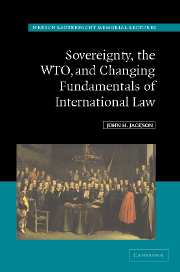Book contents
- Frontmatter
- Contents
- Preface
- Table of statutes and regulations
- Table of cases
- Part I Challenges to fundamental assumptions of international law
- Part II The WTO
- Part III The search for solutions
- 6 Policy analytical approaches and thought experiments
- 7 Illustrative applications
- 8 Perspectives and implications: some conclusions
- Appendix: Outline of the Uruguay Round treaty establishing the World Trade Organization
- Notes
- Index
7 - Illustrative applications
Published online by Cambridge University Press: 29 March 2011
- Frontmatter
- Contents
- Preface
- Table of statutes and regulations
- Table of cases
- Part I Challenges to fundamental assumptions of international law
- Part II The WTO
- Part III The search for solutions
- 6 Policy analytical approaches and thought experiments
- 7 Illustrative applications
- 8 Perspectives and implications: some conclusions
- Appendix: Outline of the Uruguay Round treaty establishing the World Trade Organization
- Notes
- Index
Summary
In the context of a globalizing world in which states acting alone cannot achieve important performance goals, only the processes of treaty-based cooperative action can overcome this growing inability to achieve those goals. This is particularly the case when it comes to economic affairs, which are often driven by global economic structures – global companies, global markets and global distribution networks – which individual states acting alone cannot effectively manage or regulate. Cooperation through a treaty institution may be the only way out.
WTO Consultative Board Report, 2005Illustrative applications – grappling with detail and diversity
In order to make more concrete some of the ideas put forward in the previous chapters of this book, Chapter 7 touches on a few illustrative applications, thus to “round out” the logic and descriptions elsewhere presented.
If anything, these short presentations illustrate the complexity of the various subjects, as well as their diversity. Clearly no single size fits all, but if the thrust of this book is understood to demystify and “de-mantra-ize” some of the older and traditional concepts of international law including those of sovereignty and the consent theory of norm legitimization, so as to reduce some of the restraints on thinking imposed by those concepts, this could be taken as at least limited success.
These applications are not selected to be comprehensive, nor to represent any judgment about relative importance.
- Type
- Chapter
- Information
- Publisher: Cambridge University PressPrint publication year: 2006

